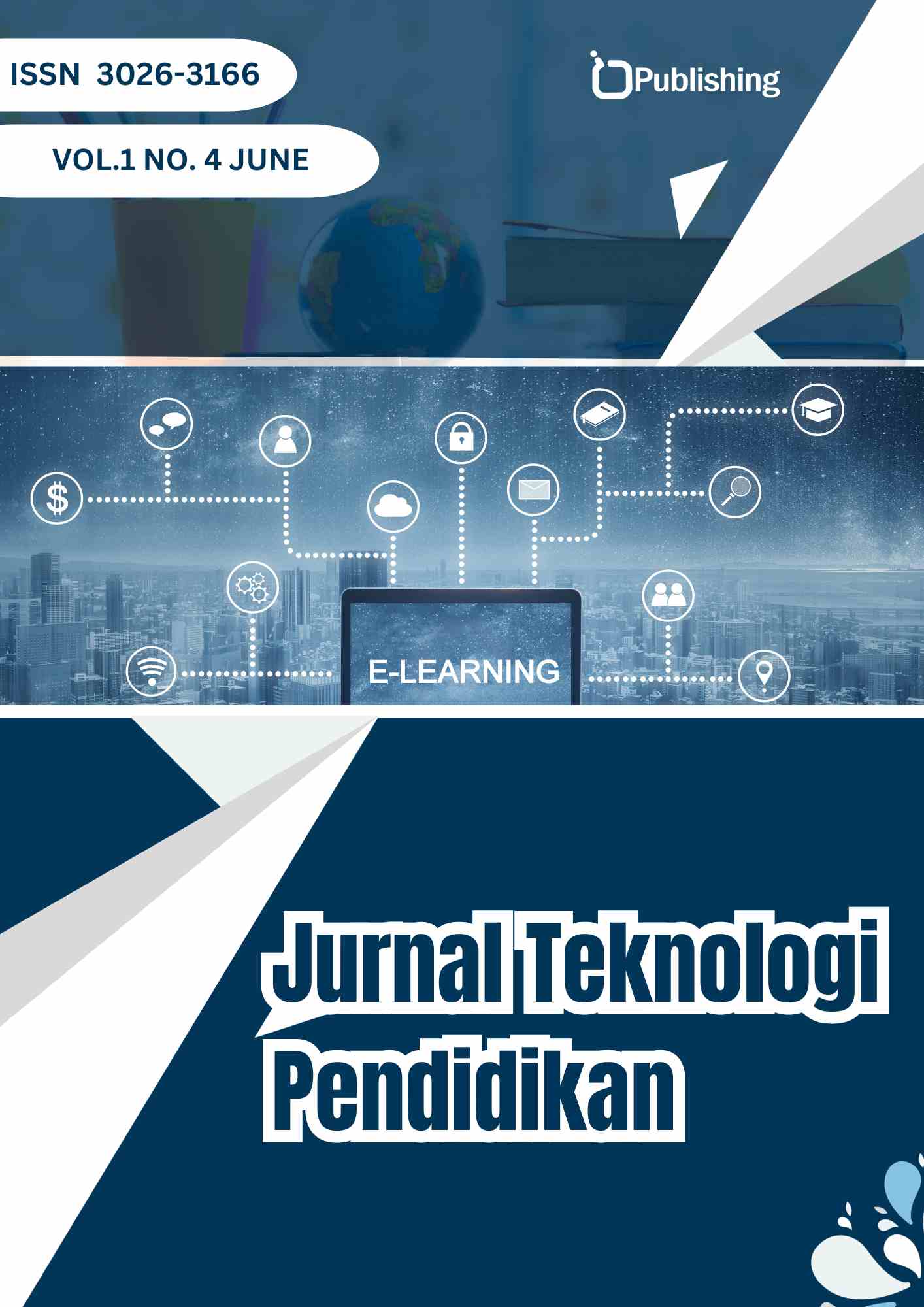Peran Teknologi Non-Visual Desktop Access (NVDA) Untuk Siswa Tunanetra dalam Proses Pembelajaran
DOI:
https://doi.org/10.47134/jtp.v1i4.606Keywords:
Teknologi Asistif, Tunanetra, NVDAAbstract
Pendidikan merupakan hak bagi seluruh masyarakat Indonesia, tak terkecuali anak-anak tunanetra yang berhak mendapatkan pendidikan yang setara dengan anak-anak non disabilitas. Siswa tunanetra dibantu dalam proses pembelajaran dengan teknologi asistif atau teknologi yang disesuaikan dengan kebutuhan siswa disabilitas yang selaras dengan kurikulum saat ini yaitu mendorong siswa untuk memiliki keterampilan dalam teknologi, salah satu teknologi asistif yang dapat membantu mereka adalah screen reader atau teknologi yang dapat membacakan teks dari komputer dari aplikasi Non-Visual Desktop Access atau NVDA. Metode yang digunakan dalam penelitian ini adalah kualitatif studi pustaka dengan analisis deskriptif agar dapat menjabarkan fenomena dengan jelas dan sistematis. Hasil penelitian menunjukkan bahwa NVDA memiliki peran yang penting dalam proses pembelajaran bagi siswa tunanetra karena menawarkan aplikasi yang gratis dari aplikasi sceen reader yang lain. NVDA juga dapat membantu mereka dalam mengoperasikan komputer, membaca buku, membaca dokumen PDF, mengerjakan tugas, dan mengakses materi pelajaran dari guru. Ada pun NVDA juga membantu meningkatkan kemandirian, keterampilan membaca, dan keterampilan menulis.
References
Australian Disability Clearinghouse on Education and Training. (2017, Juni 20). Blind and Vision Impairment: Screen Readers. https://www.adcet.edu.au/inclusive-technology/blind-and-vision-impaired/screen-readers
Bakken, J. P. (2021). Smart Universities: Assistive Technologies for Students with Visual Impairments. Smart Innovation, Systems and Technologies, 240, 453–473. https://doi.org/10.1007/978-981-16-2834-4_39 DOI: https://doi.org/10.1007/978-981-16-2834-4_39
Baktara, D. I., & Setyawan, W. (2021). Fasilitas Pendidikan Bagi Anak Tunanetra dengan Pendekatan Indera. Jurnal Sains dan Seni ITS, 9(2). https://doi.org/10.12962/j23373520.v9i2.54801 DOI: https://doi.org/10.12962/j23373520.v9i2.54801
Damastuti, E. (2021). Teknologi Asistif (C. I. Gunawan & G. Rusmayadi, Ed.; Vol. 1). CV. IRDH.
Sevgi, K. T. (2023). How Screen Readers Impact the Academic Works of College and Graduate Students with Visual Impairments. Sakarya University Journal of Education, 13(3). https://doi.org/10.19126/suje.1201482 DOI: https://doi.org/10.19126/suje.1201482
Manalu, J. B., Sitohang, P., Heriwati, N., & Turnip, H. (2022). Prosiding Pendidikan Dasar Pengembangan Perangkat Pembelajaran Kurikulum Merdeka Belajar. Mahesa Centre Research, 1(1). https://doi.org/10.34007/ppd.v1i1.174
Martins, L. A. (2018). Analysis of usability practices in a project of a free assistive technology system. ACM International Conference Proceeding Series, 512–519. https://doi.org/10.1145/3229345.3229413 DOI: https://doi.org/10.1145/3229345.3229413
Mccarthy, T. (2013). The “Voice” has it: Screen reader adoption and switching behavior among vision impaired persons in India. Assistive Technology, 25(4), 222–229. https://doi.org/10.1080/10400435.2013.768719 DOI: https://doi.org/10.1080/10400435.2013.768719
McCarthy, T. (2012). An analysis of screen reader use in India. ACM International Conference Proceeding Series, 149–158. https://doi.org/10.1145/2160673.2160694 DOI: https://doi.org/10.1145/2160673.2160694
Michailidou, S. (2023). Training a Child with Blindness on the Basic Use of Computer with the Aim of Internet Socialization; an Intervention Program. Studies in Health Technology and Informatics, 306, 351–358. https://doi.org/10.3233/SHTI230643 DOI: https://doi.org/10.3233/SHTI230643
Mohamad, M. (2018). The preliminary study of a mobile health application for visual impaired individual. ACM International Conference Proceeding Series, 97–101. https://doi.org/10.1145/3206129.3268914 DOI: https://doi.org/10.1145/3206129.3268914
Momotaz, F. (2023). Understanding the Usages, Lifecycle, and Opportunities of Screen Readers’ Plugins. ACM Transactions on Accessible Computing, 16(2). https://doi.org/10.1145/3582697 DOI: https://doi.org/10.1145/3582697
Nganji, J. T. (2015). The Portable Document Format (PDF) accessibility practice of four journal publishers. Library and Information Science Research, 37(3), 254–262. https://doi.org/10.1016/j.lisr.2015.02.002 DOI: https://doi.org/10.1016/j.lisr.2015.02.002
Nur’aisah, E., Halawati, F., & Destiyanti, I. C. (2022). Pengembangan Teknologi Pembelajaran Tunanetra (Teptun) Berbasis Screan Reader NVDA pada Mahasiswa Tunanetra. Jurnal Pendidikan dan Konseling, 4(5).
Nurhikmah, N., & Awalya, A. (2021). Pengembangan Pembelajaran Anak Penyandang Tunanetra Dengan Menggunakan Pembaca Layar NVDA Di Masa Pandemi Di SLB Al Imam Luwu. Jurnal Literasi Digital, 1(3). https://doi.org/10.54065/jld.1.3.2021.62 DOI: https://doi.org/10.54065/jld.1.3.2021.62
Pal, J. (2011). Low-cost assistive technology in the developing world: A research agenda for information schools. ACM International Conference Proceeding Series, 459–465. https://doi.org/10.1145/1940761.1940824 DOI: https://doi.org/10.1145/1940761.1940824
Pamuji, Nerri, I. A., & Niratama, F. (2023). Literature Review: Enhancing Education Accessibility: The Role of Assistive Technology in Promoting Equality for the Visually Impaired. https://doi.org/10.2991/978-2-38476-152-4_118 DOI: https://doi.org/10.2991/978-2-38476-152-4_118
Prabha, P. L. (2018). Low cost real time braille keypad for communication. International Journal of Engineering and Technology(UAE), 7(2), 77–81. https://doi.org/10.14419/ijet.v7i2.8.10334 DOI: https://doi.org/10.14419/ijet.v7i2.8.10334
Rosita, T., Rochyadi, E., & Sunardi. (2020). Teknologi Asistif dalam Pendidikan Inklusif. Journal of Elementary Education, 3(6).
Senjam, S. (2019). Assistive technology for students with visual disability: Classification matters. Kerala Journal of Ophthalmology, 31(2). https://doi.org/10.4103/kjo.kjo_36_19 DOI: https://doi.org/10.4103/kjo.kjo_36_19
Wijaya, H. W., & Sopandi, A. A. (2018). Efektivitas Program Non Visual Dekstop Access (NVDA) dalam Meningkatkan Kemampuan Membuat Dokumen Di Microsoft Word Bagi Anak Tunanetra Kelas Lanjutan. Jurnal Pendidikan Kebutuhan Khusus, 2(1).
Zallio, M., & Ohashi, T. (2022). The Evolution of Assistive Technology: A Literature Review of Technology Developments and Applications. Human Factors in Accessibility and Assistive Technology, 37. https://doi.org/10.54941/ahfe1001646 DOI: https://doi.org/10.54941/ahfe1001646
Downloads
Published
How to Cite
Issue
Section
License
Copyright (c) 2024 Aulia Hafidz Azzahra, Desy Safitri, Sujarwo Sujarwo

This work is licensed under a Creative Commons Attribution 4.0 International License.










